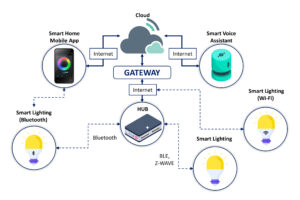Basic Bulbs Turn Smart!
Smart lighting is a cutting-edge method of lighting your home. Smart LED bulbs include software that connects to an app, smart home assistant, or other smart accessory, allowing you to automate or control your lights remotely, eliminating the need for traditional wall switches.
Lighting is becoming more intelligent. Create a variety of preset lighting moods for all activities, from weeknight cooking to weekend movie marathons. We can gently wake up to softly brightening light by setting a ‘rise and shine’ timer. With a single click of the remote control, the dimming kit white spectrum transforms the room and atmosphere from reading light to dancing light and back again.
Benefits of Smart Lighting
The benefits of smart lights extend beyond the ability to control your lights automatically or remotely — there are additional, less obvious advantages to switching to smart lighting.
- Saves Electricity ~ Users can remotely set schedules, control brightness, and control smart tights. Some smart tights can also be controlled based on occupancy. All of these features save electricity and thus lower costs.
- User Convenience ~ When you wake up in the middle of the night to go to the kitchen or somewhere else. Smart lights that detect motion can turn on automatically. This enhances the user’s experience.
- Remote Controlled ~ A user can control a connected smart lighting system remotely. For example, a smart lighting system allows you to turn on lights while you are away from home.
- User Customization ~ The majority of smart bulbs on the market can change intensity and color. As a result, based on their mood, users can select the appropriate color and intensity.
Smart Lighting Connectivity
Smart lighting makes lighting nodes individually addressable and digitally controllable by using an information carrier, such as the Internet or something similar. Network connectivity is required to communicate between the lighting nodes and the information carrier. It is typically thought to be made up of wireless devices.
That is not to say that the wired solution is without merit. The advantages of wired networking technology include high communication reliability and data transport capacity over longer distances. As a result, it can serve as the data backbone of an IP infrastructure in commercial buildings. Wireless networking is gaining popularity due to its inherent flexibility, ease of installation, and lower deployment costs when compared to cabled solutions.
Read More: The Semiconductor Chips Crisis: Where Do We Stand?
The communication technologies listed below are used to connect lighting systems to the internet or a smartphone and control them remotely.
- Wi-Fi Connected System ~ Wi-Fi-based smart lights are network-connected and can be controlled remotely via Wi-Fi routers. However, they cannot be controlled unless an internet connection is available.
- Bluetooth Connected Smart Lights ~ Bluetooth-enabled smart lights can form a mesh network and be controlled by smartphones that support BLE. A Bluetooth Hub is required to remotely control Bluetooth-based smart lights. A Bluetooth hub is a device that connects Bluetooth-enabled devices to the internet.
- ZigBee / Z-Wave Connected System ~ ZigBee and Z-wave-based smart lights, like Bluetooth-based lights, form a mesh network. They cannot, however, be controlled without Hub. A ZigBee / Z-Wave Hub is required to control them.

Smart Lighting Architecture
Lighting control systems can be wired, wireless, or a hybrid of both (hybrid). The system architecture describes how control signals are communicated rather than how a control device is powered.
Control signals in a typical wired lighting control system travel over communication wires. Control devices in a wireless system communicate over the air using radio-frequency RF waves, eliminating the need for wires. Hybrid solutions use wired in areas where it is feasible (such as new construction) and wireless as an extension of the wired network to provide coverage in difficult-to-reach areas or where wiring is prohibitively expensive.
Many factors influence the choice of architecture for a specific site, including whether it is new construction or an existing building, the space or building itself, installation requirements, and overall costs.
In Conclusion..
Smart lighting has a bright future, with opportunities in both the residential and commercial sectors. By utilizing smart lighting networks, you can reduce customer energy consumption while also improving the health and wellness of your family.




